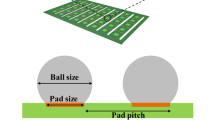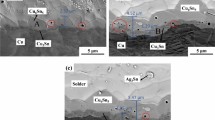Abstract
In the current study, the size effect on microstructure and tensile property of Sn3.0Ag0.5Cu (SAC305) solder joint is investigated. Experiments were performed to solder joints with thickness from 50 μm to 2 mm. The intermetallic compound (IMC) growth rate of solder joints is found to be dependent on the size of solder joints. After soldering procedure, the IMC of smaller size solder joints is thinner than that of larger size solder joints. It is also found that the average grain size of IMC increases with decreasing of the joint size. To better understand the difference of IMC growth during solid-state and liquid-state thermal aging, experiments were performed at 210 and 300 °C, respectively. IMC thickness of solder joints after 210 and 300 °C of thermal aging was measured. It is found that the size effect on IMC growth rate at solid-state and liquid-state is different. The IMC growth rate of smaller size solder joints is higher than larger size solder joints under solid-state thermal aging. Under liquid-state reaction, the IMC growth rate of smaller size solder joints is slower. ‘H’ type and hexagonal prism of Cu6Sn5 were observed in 2 and 1 mm thickness size solder joint, respectively. Fewer Cu6Sn5 prism was found in 50 μm thickness solder joints. Tensile strengths of solder joints with different sizes were measured. The solder joints showed ductile to brittle fracture transition with the decreasing of joints thickness. The H-field fracture criterion is employed to predict the tensile strength of Sn3.0Ag0.5Cu solder joints with different thickness.

















Similar content being viewed by others
References
Y.S. Park, Y.M. Kwon, J.T. Moon, Y.W. Lee, Effects of fine size lead-free solder ball on the interfacial reactions and joint reliability. in Proceedings of Electronic Components and Technology Conference, (IEEE, 2010) pp. 1436–1441.
W.K. Choi, S.K. Kang, D.Y. Shih, A study of the effects of solder volume on the interfacial reactions in solder joints using the differential scanning calorimetry technique. J. Electron. Mater. 31(11), 1283–1291 (2002)
C.C. Chang, Y.W. Lin, Y.W. Wang, C.R. Kao, The effects of solder volume and Cu concentration on the consumption rate of Cu pad during reflow soldering. J. Alloys Compd. 492, 99–104 (2010)
L.M. Yin, X.P. Zhang, C. Lu, Size and volume effects on the strength of microscale, lead-free solder joints. J. Electron. Mater. 38(10), 2179–2183 (2009)
H.B. Qin, X.P. Zhang, M.B. Zhou, J.B. Zeng, Y.W. Mai, Size and constraint effects on mechanical and fracture behavior of micro-scale Ni/Sn3.0Ag0.5Cu/Ni solder joints. Mat. Sci. Eng. A 617(1), 14–23 (2014)
Y. Wang, I.M. De Rosa, K.N. Tu, Size effect on ductile-to-brittle transition in Cu-solder-Cu micro-joints. IEEE Electronic Components and Technology Conference 632–639 (2015)**
P. Zimprich, U. Saeed, A. Betzwar-Kotas, Mechanical size effects in miniaturized lead-free solder joints. J. Electron. Mater. 37(1), 102–109 (2008)
M.L. Huang, F. Zhang, F. Yang, N. Zhao, Size effect on tensile properties of cu/sn–9zn/cu solder interconnects under aging and current stressing. J. Mater. Sci. 26(4), 1–8 (2015)
K.S. Kim, S.H. Huh, K. Suganuma, Effects of intermetallic compounds on properties of Sn–Ag–Cu lead-free soldered joints. J. Alloy Compd. 352(1–2), 226–236 (2003)
Y.D. Han, H.Y. Jing, SML Nai, L.Y. Xu, C.M. Tan, J. Wei, Interfacial reaction and shear strength of Ni-coated carbon nanotubes reinforced Sn–Ag–Cu solder joints during thermal cycling. Intermetallics 31(12), 72–78 (2012)
T. An, F. Qin, Relationship between the intermetallic compounds growth and the microcracking behavior of lead-free solder joints. J. Electron. Packag. 138(1), 011002 (2016)
Y. Yao, R. An, X. Long, Effect of electric current on mechanical behaviour of Sn-Ag-Cu solder joints. Eng. Fract. Mech. 171, 85–97 (2017)
A.M. Gusak, K.N. Tu, Kinetic theory of flux-driven ripening. Phys. Rev. B 66(11), 115403 (2002)
G. Zeng, S. Xue, L. Zhang, L. Gao, W. Dai, J. Luo, A review on the interfacial intermetallic compounds between Sn–Ag–Cu based solders and substrates. J. Mater. Sci. 21(5), 421–440 (2010)
Y. Tian, R. Zhang, C. Hang, L. Niu, C. Wang, Relationship between morphologies and orientations of Cu6Sn5 grains in Sn3.0Ag0.5Cu solder joints on different Cu pads. Mater Charact 88(2), 58–68 (2013)
K.N. Tu, Reliability challenges in 3D IC packaging technology. Microelectron. Reliabil 51(3), 517–523 (2011)
Y. Yao, L.M. Keer, M.E. Fine, Modeling the failure of intermetallic/solder interfaces. Intermetallics 18(18), 1603–1611 (2010)
Y. Yao, L.M. Keer, Cohesive fracture mechanics based numerical analysis to BGA packaging and lead free solders under drop impact. Microelectron. Reliabil. 53(4), 629–637 (2013)
SPV Nadimpalli, J.K. Spelt, Fracture load prediction of lead-free solder joints. Eng. Fract. Mech. 77(17), 3446–3461 (2010)
X. Hu, T. Xu, L.M. Keer, Y. Li, X. Jiang, Shear strength and fracture behavior of reflowed Sn3.0Ag0.5Cu/Cu solder joints under various strain rates. J. Alloy Compd. 690, 720–729 (2017)
Y. Suzuki, Adhesive tensile strengths of scarf and butt joints of steel plates (relation between adhesive layer thicknesses and adhesive strengths of joints): solid-mechanics, strength of materials. Nihon Kikai Gakkai Ronbunshu A Hen/Trans. Jpn. Soc. Mech. Eng. A 53(487), 514–522 (1987)
G.C. Sih, J.W. Ho, Sharp notch fracture strength characterized by critical energy density. Theor. Appl. Fract. Mech. 16(3), 179–214 (1991)
A.R. Akisanya, C.S. Meng, Initiation of fracture at the interface corner of bi-material joints. J. Mech. Phys. Solids 51(1), 27–46 (2003)
D.B. Bogy, Two edge-bonded elastic wedges of different materials and wedge angles under surface tractions. Int. J. Appl. Mech. 38(2), 377–386 (1971)
D.B. Bogy, Edge-bonded dissimilar orthogonal elastic wedges under normal and shear loading. Int. J. Appl. Mech. 35(3), 460 (1968)
R.I. Babicheva, K.A. Bukreeva, S.V. Dmitriev, R.R. Mulyukov, K. Zhou, Strengthening of NiAl nanofilms by introducing internal stresses. Intermetallics 43, 171–176 (2013)
X. Long, Y.X. Wang, L.M. Keer, Y. Yao, Mechanical effects of isolated defects within a lead-free solder bump subjected to coupled thermal-electrical loading. J. Micromech. Mol. Phys. 1, 165004 (2016)
Z. Qian, A.R. Akisanya, An experimental investigation of failure initiation in bonded joints. Acta Mater. 46(14), 4895–4904 (1998)
Acknowledgements
This work was supported by the National Natural Science Foundation of China (No. 11572249 and 51508464). This work was also partially supported by “the Fundamental Research Funds for the Central Universities” (No. 3102016ZY017).
Author information
Authors and Affiliations
Corresponding author
Rights and permissions
About this article
Cite this article
Wang, S., Yao, Y. & Long, X. Size effect on microstructure and tensile properties of Sn3.0Ag0.5Cu solder joints. J Mater Sci: Mater Electron 28, 17682–17692 (2017). https://doi.org/10.1007/s10854-017-7706-8
Received:
Accepted:
Published:
Issue Date:
DOI: https://doi.org/10.1007/s10854-017-7706-8




